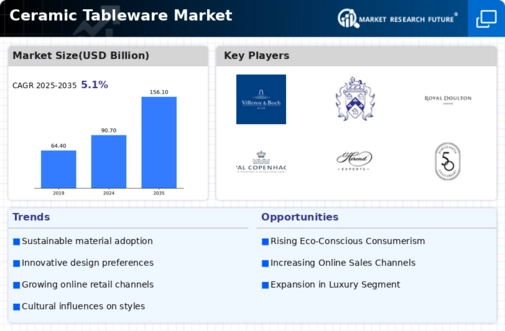Market Growth Projections
Growth of the Hospitality Sector
The Global Ceramic Tableware Market Industry is significantly influenced by the expansion of the hospitality sector. As hotels, restaurants, and cafes proliferate globally, the demand for high-quality ceramic tableware increases correspondingly. Establishments are investing in premium tableware to enhance customer experiences and differentiate themselves in a competitive market. This trend is particularly pronounced in emerging economies where the hospitality industry is rapidly developing. The anticipated growth of the hospitality sector is expected to contribute to the market's projected value of 156.1 USD Billion by 2035, indicating a robust correlation between hospitality growth and ceramic tableware demand.
Cultural Influences on Dining Practices
Cultural influences significantly impact the Global Ceramic Tableware Market Industry, as diverse dining practices shape consumer preferences for tableware. In many cultures, ceramic tableware is not only functional but also holds cultural significance, often being used in traditional ceremonies and gatherings. This cultural attachment drives demand for specific designs and styles that reflect heritage and tradition. As globalization continues to influence culinary practices, the market is likely to see a blend of traditional and contemporary designs, catering to a diverse consumer base. This cultural interplay may enhance market growth by appealing to both local and international consumers.
Technological Advancements in Manufacturing
Technological advancements play a crucial role in shaping the Global Ceramic Tableware Market Industry. Innovations in manufacturing processes, such as 3D printing and automated glazing techniques, enhance production efficiency and product quality. These advancements enable manufacturers to create intricate designs and reduce production costs, thereby appealing to a broader consumer base. Furthermore, the integration of technology facilitates customization options, allowing consumers to personalize their tableware. As a result, the industry is likely to experience increased competition and innovation, driving growth and expanding market opportunities in the coming years.
Sustainability Trends in Tableware Production
Sustainability emerges as a pivotal driver in the Global Ceramic Tableware Market Industry. With heightened awareness of environmental issues, consumers are gravitating towards eco-friendly products. Manufacturers are increasingly adopting sustainable practices, such as using natural materials and reducing waste during production. This shift not only aligns with consumer values but also enhances brand loyalty. The market is likely to benefit from this trend as companies that prioritize sustainability may capture a larger share of the market. As a result, the industry is expected to witness a compound annual growth rate of 5.06% from 2025 to 2035, reflecting the growing importance of sustainability in consumer choices.
Rising Consumer Demand for Aesthetic Tableware
The Global Ceramic Tableware Market Industry experiences a notable surge in consumer demand for aesthetically pleasing tableware. As dining experiences evolve into social events, consumers increasingly seek ceramic tableware that combines functionality with artistic design. This trend is particularly evident in urban areas where dining out and hosting gatherings are prevalent. The market's value is projected to reach 90.7 USD Billion in 2024, driven by the desire for unique and visually appealing products. Manufacturers are responding by introducing innovative designs and limited-edition collections, which cater to the growing consumer preference for personalized dining experiences.





















